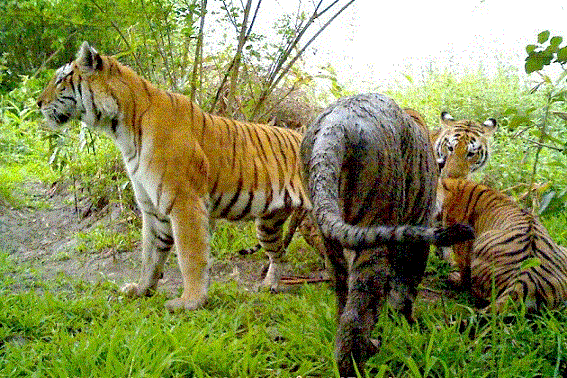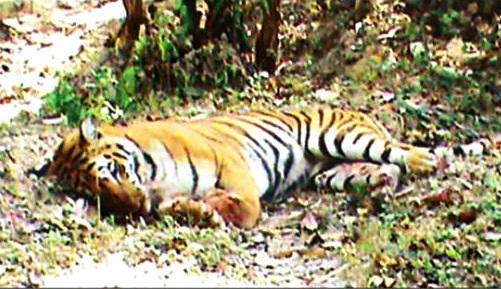Greater One-Horned Rhinoceros, also known as Indian Rhinoceros, is exclusively found in Assam state of North-East India and in the in the Terai region of Nepal. Its most significant difference to African Rhinoceros is the single horn on its head compared to two horns of the African counterpart.
The Scientific Name: Rhinoceros Unicornis
Where is it found?
One-horned rhinos once ranged across the entire northern part of the Indian subcontinent, along the Indus, Ganges and Brahmaputra River basins, from Pakistan to the Indian-Burmese border, including parts of Nepal, Bangladesh and Bhutan. They may have also existed in Myanmar, southern China and Indochina. But their habitat shrunk due to human influences and now confined to only eastern region of India and Terai region of Nepal. Two Third of the wild population of the species is found in Brahmaputra valley of Assam, North-East India only. Kaziranga National Park in Assam is home to more than 1500 One Horned Rhinoceros.
How does it look?
Greater one horned rhino is the largest living species of Rhinoceros, with African White Rhinoceros. The males are larger in size than the females. It weighs 1800 – 3000 Kg on average, but the largest specimen is known to have weighed around 4000 kg. Males have an average length of 3.1–3.8 meters with a shoulder height of 1.6-2.0 meters, while females have an average length of 3.0–3.4 meters and a shoulder height of 1.4-1.8 meters(6 feet). Greater one-horned rhinos have one horn, present in both adult male and female. It typically grows around 20 cm long, and weighs up to 2-3 kg. The longest ever recorded horn is 58 cm. The horn is pure keratin, has the same structure as the hooves of horses and re-grows if broken. It is not used for fighting but for the search of food and foraging for roots. Armour-plating appearance is the most interesting feature of Greater one horn rhino along with it’s horn. The Armour plating is actually thick folds of shin. Several prominent folds of skin protect the neck. The skin can have a maximum thickness of 4 cm; the subcutaneous fat is 2-5 cm thick and well supplied with blood, which helps therm-regulation, so that the animal is able to regulate its own body temperature in varying weather conditions. Between the folds, around the stomach, the inner legs and the facial area, the skin is rather soft and thin.
How does it live?
The Indian One horn Rhinoceros live on wide variety plants, mainly grass, fruits, leaves, branches of trees, shrubs, submerged and floating aquatic plants and sometimes agricultural crops too. Due to their love of aquatic plants, they are usually found near water sources. Socially the One-horned Rhinos mostly live in solitary. Two mature Rhinos are found together only during mating season. The calf accompany mother up to 4 years. Sometimes mother allow even the older calf to accompany with a new born. Though the One horn Rhinos are solitary in nature, they are usually friendly to each other when confronted. But males are known to fight with each other and this fights can even turn out to be fatal to the weaker contender at times. The territories of males are also defined loosely and often overlaps. The territory can extend 4-8 square km in area. The female attains maturity at the age of 7 years while the males after 10-12 years. The gestation period is 16 months. The average life of One-horned Rhino is around 40 years. The maximum recorded age is 47 years.
What are the threats?
In the early 20th century the One horn Rhinoceros almost reached a phase of extinction. This was attributed to habitat shrinking due to human population rise and agriculture. Sport hunting during 1800-1900 was another grave reason to it’s decline. According to reports, in 1908 only 12 Rhinos were surviving in the Kaziranga. But strict conservation measures were put for the species and the population increased encouragingly in specific pockets. But the Rhino faced extinction in most of the ranges in northern India. In recent times, poaching is considered as the most alarming threat to the Greater One Horn Rhinoceros. In Traditional Chinese belief, the Horn of the Rhino is considered cure to many diseases like fever, rheumatism, gout etc. and also it is considered as aphrodisiac. Like China, the Rhino horn has traditional demand in various other countries of Asia. Though there is no scientific base for all these believes, the Rhino horn fetches exotic price in the black market. This is the main reason for increasing poaching of the species which mounts to more than hundred every year. Apart from poaching, Rhino habitat mostly coincides with populous human habitats. This continuously is bringing the wetlands and other habitat of the species as those lands are converted into cultivation. Increasing human-wildlife conflicts also is a major threat to the species. In some places, human interventions have also brought invasive alien plants into Rhino habitat shrinking their food availability.
Conservation Efforts
Since the beginning of 20th century, major conservation efforts have been put to save the Magnificent Rhino species. All Rhinos in wild now live in special protected zones in both India and Nepal. There are anti-poaching measures placed in all these zones, but it requires strict implementation and proper infrastructure and resources. There have been efforts to prevent invasive plants and also to increase the area of habitat. The species is listed in CITES Appendix I since 1975. WWF has been very active in conserving the species along with other local organizations. There have been also efforts on translocation of the One horn Rhino since 1980s.







Recent Comments